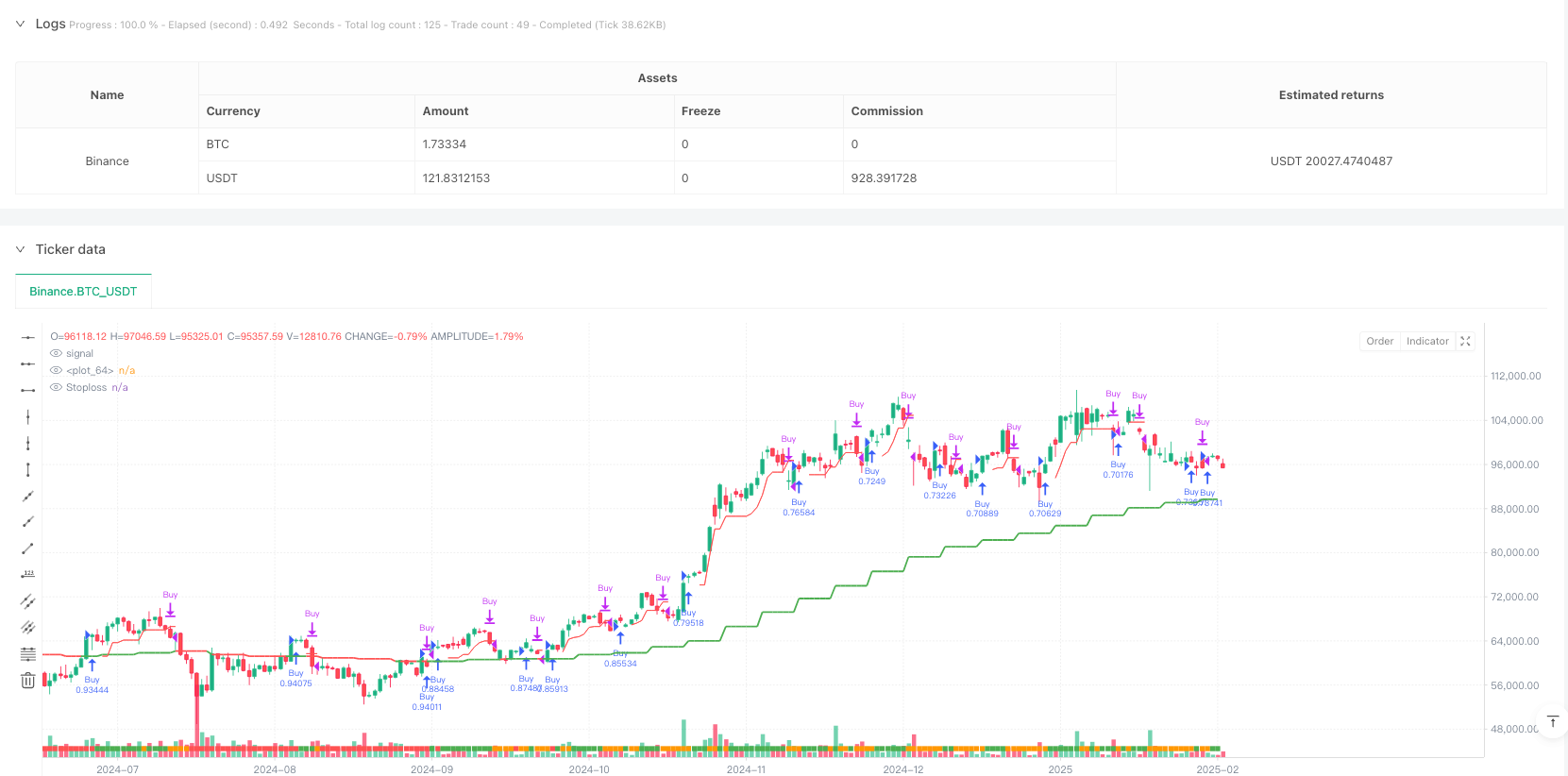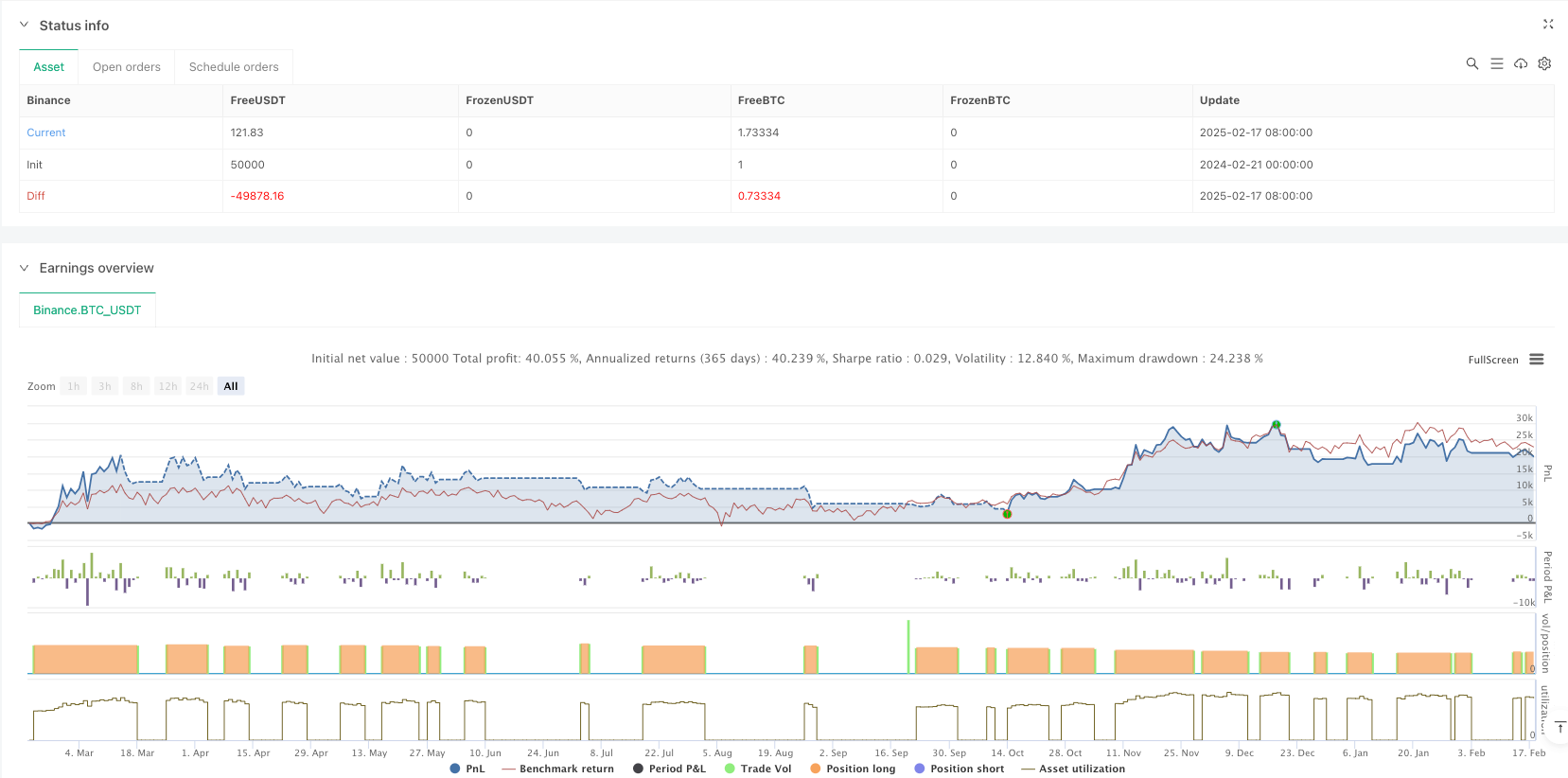

概述
该策略是一个基于跨周期分析的趋势跟踪交易系统,结合了周线和日线级别的EMA均线以及RSI指标来识别市场趋势和动量。策略通过多重时间框架的趋势一致性来确定交易机会,并使用基于ATR的动态止损来管理风险。系统采用资金管理模式,每次交易使用账户100%的资金,并考虑了0.1%的交易手续费。
策略原理
策略的核心逻辑基于以下几个关键要素: 1. 使用周线级别的EMA作为主要趋势过滤器,结合日线收盘价与周线EMA的关系来确定市场状态 2. 通过ATR指标动态调整趋势判定的阈值,增加策略的适应性 3. 整合RSI动量指标作为额外的交易过滤条件 4. 使用基于7天最低价和ATR的追踪止损系统 5. 当出现过度上涨的警告信号时,策略会暂停开仓以规避风险
策略优势
- 多重时间框架分析提供了更全面的市场视角,能够有效过滤假突破
- 动态止损机制根据市场波动性自适应调整,提供了灵活的风险控制
- RSI动量过滤器帮助确认趋势强度,提高入场质量
- 系统包含过度上涨的预警机制,有助于规避回撤风险
- 策略的参数可调整性强,便于根据不同市场环境进行优化
策略风险
- 在横盘市场中可能频繁进出导致交易成本增加
- 使用100%资金进行交易存在较大的回撤风险
- 依赖技术指标可能在市场突发事件时反应不及时
- 多重时间框架分析可能在不同级别出现矛盾信号
- 追踪止损可能在剧烈波动时被过早触发
策略优化方向
- 引入波动率过滤器,在低波动期间减少交易频率
- 添加仓位管理系统,根据市场状态动态调整持仓比例
- 整合基本面指标,提供额外的市场环境判断
- 优化追踪止损参数,使其更好地适应不同的市场阶段
- 加入交易量分析,提高趋势判断的准确性
总结
这是一个结构完整、逻辑清晰的趋势跟踪策略。通过多重时间框架分析和动态指标过滤,策略能够较好地捕捉主要趋势。虽然存在一些固有风险,但通过参数优化和添加补充指标,策略仍有较大的改进空间。建议在实盘交易前进行充分的回测,并根据具体的市场环境调整参数设置。
策略源码
/*backtest
start: 2024-02-21 00:00:00
end: 2025-02-18 08:00:00
period: 1d
basePeriod: 1d
exchanges: [{"eid":"Binance","currency":"BTC_USDT"}]
*/
// @version=6
strategy("Bitcoin Regime Filter Strategy", // Strategy name
overlay=true, // The strategy will be drawn directly on the price chart
initial_capital=10000, // Initial capital of 10000 USD
currency=currency.USDT, // Defines the currency used, USDT
default_qty_type=strategy.percent_of_equity, // Position size will be calculated as a percentage of equity
default_qty_value=100, // The strategy uses 100% of available capital for each trade
commission_type=strategy.commission.percent, // The strategy uses commission as a percentage
commission_value=0.1) // Transaction fee is 0.1%
// User input
res = input.timeframe(title = "Timeframe", defval = "W") // Higher timeframe for reference
len = input.int(title = "EMA Length", defval = 20) // EMA length input
marketTF = input.timeframe(title = "Market Timeframe", defval = "D") // Current analysis timeframe (D)
useRSI = input.bool(title = "Use RSI Momentum Filter", defval = false) // Option to use RSI filter
rsiMom = input.int(title = "RSI Momentum Threshold", defval = 70) // RSI momentum threshold (default 70)
// Custom function to output data
f_sec(_market, _res, _exp) => request.security(_market, _res, _exp[barstate.isrealtime ? 1 : 0])[barstate.isrealtime ? 0: 1]
// The f_sec function has three input parameters: _market, _res, _exp
// request.security = a Pine Script function to fetch market data, accessing OHLC data
// _exp[barstate.isrealtime ? 1 : 0] checks if the current bar is real-time, and retrieves the previous bar (1) or the current bar (0)
// [barstate.isrealtime ? 0 : 1] returns the value of request.security, with a real-time check on the bar
// Define time filter
dateFilter(int st, int et) => time >= st and time <= et
// The dateFilter function has two input parameters: st (start time) and et (end time)
// It checks if the current bar's time is between st and et
// Fetch EMA value
ema = ta.ema(close, len) // Calculate EMA with close prices and input length
htfEmaValue = f_sec(syminfo.tickerid, res, ema) // EMA value for high time frame, using f_sec function
// Fetch ATR value
atrValue = ta.atr(5)
// Check if price is above or below EMA
marketPrice = f_sec(syminfo.tickerid, marketTF, close)
regimeFilter = marketPrice > (htfEmaValue + (atrValue * 0.25)) // Compare current price with EMA in higher timeframe (with ATR dependency)
// Calculate RSI value
rsiValue = ta.rsi(close, 7)
// Bullish momentum filter
bullish = regimeFilter and (rsiValue > rsiMom or not useRSI)
// Set caution alert
caution = bullish and (ta.highest(high, 7) - low) > (atrValue * 1.5)
// Set momentum background color
bgCol = color.red
if bullish[1]
bgCol := color.green
if caution[1]
bgCol := color.orange
// Plot background color
plotshape(1, color = bgCol, style = shape.square, location = location.bottom, size = size.auto, title = "Momentum Strength")
plot(htfEmaValue, color = close > htfEmaValue ? color.green : color.red, linewidth = 2)
// Initialize trailing stop variable
var float trailStop = na
// Entry logic
if bullish and strategy.position_size == 0 and not caution
strategy.entry(id = "Buy", direction = strategy.long)
trailStop := na
// Trailing stop logic
temp_trailStop = ta.highest(low, 7) - (caution[1] ? atrValue * 0.2 : atrValue)
if strategy.position_size > 0
if temp_trailStop > trailStop or na(trailStop)
trailStop := temp_trailStop
// Exit logic
if (close < trailStop or close < htfEmaValue)
strategy.close("Buy", comment = "Sell")
// Plot stop loss line
plot(strategy.position_size[1] > 0 ? trailStop : na, style = plot.style_linebr, color = color.red, title = "Stoploss")
相关推荐